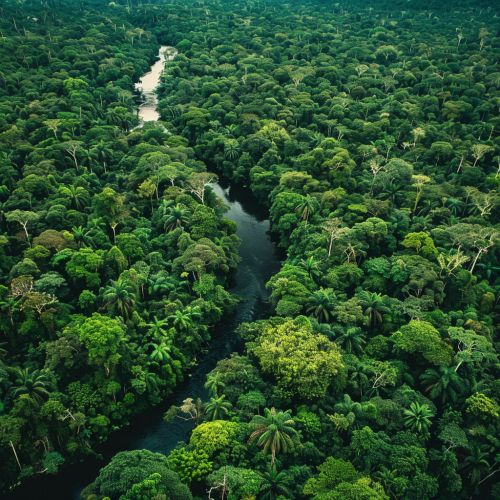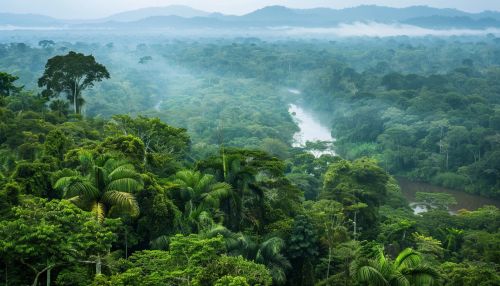Cariban languages
Introduction
The Cariban languages constitute a significant language family indigenous to northern South America, primarily found in the regions of Venezuela, Brazil, Guyana, Suriname, and French Guiana. This language family is notable for its complex phonological and grammatical structures, as well as its historical and cultural significance among the indigenous peoples of the Amazon Basin and surrounding areas.
Historical Background
The Cariban languages have a rich historical context that dates back thousands of years. Archaeological evidence suggests that the Cariban-speaking peoples have inhabited the Amazon Basin and its peripheries since prehistoric times. The spread of Cariban languages is believed to have been influenced by migration patterns, trade routes, and intertribal relations.
Classification and Distribution
The Cariban language family is divided into several branches, each containing multiple languages. The primary branches include:
- **Northern Cariban**: Includes languages such as Kari'nja (Carib), Galibi, and Wayana.
- **Central Cariban**: Encompasses languages like Akuriyo and Tiriyo.
- **Southern Cariban**: Contains languages such as Apalaí and Ikpeng.
These languages are distributed across a vast geographical area, with significant concentrations in the Guiana Shield and the Amazon Basin.
Phonology
The phonological systems of Cariban languages are characterized by a range of distinctive features. These include:
- **Consonant Inventory**: Cariban languages typically have a rich inventory of consonants, including stops, nasals, fricatives, and approximants. Voicing contrasts are common, and some languages exhibit complex consonant clusters.
- **Vowel Systems**: The vowel systems in Cariban languages generally consist of five to seven vowels. Vowel length and nasalization are phonemic in several languages.
- **Tonal and Stress Patterns**: While most Cariban languages are not tonal, stress patterns play a crucial role in distinguishing meaning. Stress is often predictable based on syllable structure and morphological rules.
Morphology
Cariban languages exhibit a high degree of morphological complexity. Key features include:
- **Agglutination**: Cariban languages are predominantly agglutinative, meaning that they form words by stringing together morphemes, each carrying a specific meaning or grammatical function.
- **Verb Morphology**: Verbs in Cariban languages are highly inflected, with markers for tense, aspect, mood, person, and number. Verb stems can be modified through various affixes to indicate these grammatical categories.
- **Noun Classification**: Many Cariban languages use noun classifiers, which are affixes or particles that categorize nouns based on semantic properties such as shape, size, and animacy.
Syntax
The syntactic structures of Cariban languages are diverse but share several common features:
- **Word Order**: The basic word order in Cariban languages is typically Subject-Object-Verb (SOV). However, variations can occur due to topicalization, focus, and other discourse-related factors.
- **Case Marking**: Cariban languages often employ case marking to indicate grammatical relations. This can be achieved through suffixes or postpositions.
- **Clause Structure**: Complex sentences in Cariban languages can involve coordination and subordination. Relative clauses, complement clauses, and adverbial clauses are commonly used to convey intricate meanings.
Sociolinguistic Context
The Cariban languages are spoken by various indigenous communities, each with its own cultural practices and traditions. The sociolinguistic context of these languages is shaped by factors such as:
- **Bilingualism and Multilingualism**: Many Cariban-speaking communities are bilingual or multilingual, often speaking a Cariban language alongside a national language or another indigenous language.
- **Language Vitality**: The vitality of Cariban languages varies widely. Some languages, like Kari'nja, have relatively large speaker populations and are actively transmitted to younger generations. Others, such as Akuriyo, are critically endangered with only a handful of speakers remaining.
- **Language Revitalization**: Efforts to revitalize and preserve Cariban languages are underway in several communities. These initiatives include language documentation, educational programs, and the promotion of cultural heritage.
Cultural Significance
The Cariban languages are deeply intertwined with the cultural identities of their speakers. They play a crucial role in the transmission of oral traditions, myths, and historical narratives. Cariban languages also serve as a medium for expressing traditional knowledge related to the environment, medicinal practices, and social organization.
Notable Languages and Dialects
Several Cariban languages and dialects are noteworthy for their linguistic features and cultural importance:
- **Kari'nja (Carib)**: One of the most widely spoken Cariban languages, Kari'nja has a significant number of speakers in Suriname, Guyana, and Venezuela. It is known for its rich oral literature and complex verb morphology.
- **Wayana**: Spoken in the border regions of Brazil, Suriname, and French Guiana, Wayana is notable for its intricate system of noun classifiers and its role in intertribal communication.
- **Apalaí**: This language is spoken by the Apalaí people in Brazil and is characterized by its extensive use of evidential markers, which indicate the source and reliability of information.
Linguistic Research and Documentation
The study of Cariban languages has attracted the attention of linguists and anthropologists for over a century. Key areas of research include:
- **Descriptive Linguistics**: Comprehensive grammars, dictionaries, and phonetic studies have been produced for several Cariban languages. These works provide detailed descriptions of phonological, morphological, and syntactic features.
- **Historical Linguistics**: Researchers have investigated the historical relationships between Cariban languages, reconstructing proto-languages and tracing the evolution of linguistic features over time.
- **Sociolinguistics**: Studies on language use, bilingualism, and language shift in Cariban-speaking communities offer insights into the social dynamics influencing language change and maintenance.
Challenges and Future Directions
The Cariban languages face numerous challenges, including language endangerment, loss of traditional knowledge, and the impact of globalization. Future directions for research and revitalization efforts include:
- **Language Documentation**: Continued efforts to document and archive Cariban languages are essential for preserving linguistic diversity. This includes the creation of audio and video recordings, as well as written materials.
- **Community Involvement**: Engaging indigenous communities in language preservation initiatives is crucial. Empowering native speakers to take an active role in documentation and revitalization can enhance the sustainability of these efforts.
- **Technological Integration**: Utilizing digital tools and platforms to create accessible language resources, such as online dictionaries, language learning apps, and multimedia content, can support the revitalization of Cariban languages.


See Also
References
- Aikhenvald, Alexandra Y. (1999). "The Arawakan Languages." In The Amazonian Languages, edited by R. M. W. Dixon and Alexandra Y. Aikhenvald, 65-106. Cambridge: Cambridge University Press.
- Derbyshire, Desmond C., and Geoffrey K. Pullum, eds. (1986). Handbook of Amazonian Languages. Vol. 1-4. Berlin: Mouton de Gruyter.
- Gildea, Spike. (1998). On Reconstructing Grammar: Comparative Cariban Morphosyntax. Oxford: Oxford University Press.
